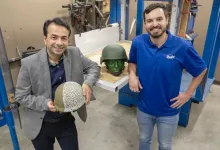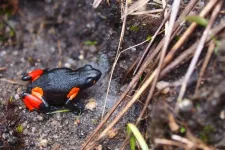(Press-News.org) The deadly H5N1 avian influenza virus, which has killed millions of birds worldwide since 2021 – and in rare cases can be transmitted to humans – may be spread through the food-stealing behaviour of some seabirds.
A study published today in the journal Conservation Letters highlights food theft – also known as ‘kleptoparasitism’, where some seabird species like frigatebirds and skuas force other birds to regurgitate their prey – as a possible transmission path for the spread of avian flu.
Led by scientists from UNSW Sydney’s Centre for Ecosystem Science and involving BirdLife International, Deakin University, and Monash University, the researchers analysed existing information about frigatebird and skua distribution, behaviour and movements, while searching through a global database for records of them contracting the virus. They also looked at the literature available to see which species of seabird the frigatebirds and skua target with kleptoparasitism.
Lead author Simon Gorta from UNSW Science says the study could provide a new focus in determining how and where the spread of the deadly virus may originate and how it could be transmitted among individuals, populations, and at the continental or ocean-basin scale.
“Understanding transmission is critical to monitoring and management efforts, particularly when at-risk species or regions are involved, and it’s helpful to understand threats to other animals and people,” says lead author Simon Gorta, a PhD student with UNSW.
“While the original H5N1 virus first emerged in 1996, the current 2.3.4.4b strain has spread far more than other strains, and is highly virulent, killing hundreds of thousands of wild seabirds since being first detected in 2021.”
Previously restricted largely to Eurasia and Africa, the virus spread to North America in 2021 and South America in late 2022. It reached Antarctica in early 2024, and has been declared a panzootic – a pandemic among animals.
Seabirds at risk and capable of transmitting the disease
Marine species, such as seabirds, have been particularly hard-hit by the panzootic.
“As one of the most threatened groups of birds on the planet, the fact that seabirds have proven to be particularly vulnerable to diseases like this is of great concern,” says co-author A/Prof. Rohan Clarke from Monash University.
Co-author Professor Richard Kingsford says the seabirds are especially vulnerable because of the way they group when breeding.
“Transmission among seabirds is a real concern because of their close contact and potential contamination of communal resources on densely-packed breeding islands, as well as particular behaviours like predation and scavenging of infected individuals,” he says.
But now the researchers say another behaviour may play an important role here: food theft or “kleptoparasitism”. This is a widespread behaviour in seabirds, commonly practiced by frigatebirds and skuas which the researchers focused on in their study.
This process involves a kleptoparasitic bird stealing food from another bird by forcing it to regurgitate its prey. If the bird the kleptoparasite targets is infected, the regurgitated food item could be coated in saliva with a high viral load, which could then infect the kleptoparasite, which in turn could infect others.
The researchers highlighted that this pathway of transmission could lead to transmission of the disease into new populations, but could also be carried long distances if birds become infectious on migration.
“Many seabirds, including these kleptoparasitic species, cover tens of thousands of kilometres in their migrations,” says Alex Berryman, Red List Officer for BirdLife International.
“If kleptoparasites become infected during these migrations and come into contact with other individuals in a way that can facilitate transmission soon after, the disease could spread into new, threatened, and previously unexposed populations and regions.”
Early detection is key
While the H5N1 2.3.4.4b has not yet reached Australia, monitoring for early detection of the disease when it arrives – rather than if – is underway.
"Birds globally are already under greater threat than ever before – it is critical the risk posed by bird flu is properly researched and managed," Mr Gorta says.
“We have identified that migratory kleptoparasites, alongside predatory and scavenging species, could be some of the first species to become infected when H5N1 reaches Australia.”
These insights will contribute to the coordinated management of avian influenza in Australia, including the National Avian Influenza Wild Bird Surveillance Program.
The researchers say this is important for guiding Australia’s preparedness for the arrival of the disease on its shores, including vulnerable subantarctic islands.
END
‘Food theft’ among seabirds could be transmission point for deadly avian flu
2024-09-16
ELSE PRESS RELEASES FROM THIS DATE:
SwRI and UTSA developing helmet pads to reduce traumatic brain injury in military service members
2024-09-16
SAN ANTONIO — September 16, 2024 —Researchers from Southwest Research Institute (SwRI) and The University of Texas at San Antonio (UTSA) are creating innovative military helmet pads designed to prevent traumatic brain injury (TBI). The project, led by SwRI’s Dr. Daniel Portillo and UTSA’s Dr. Morteza Seidi, is supported by a $125,000 grant from the Connecting through Research Partnerships (Connect) program.
Traumatic brain injury can affect human performance and quality of life. It is ...
Waiting is the hardest part: Medical field should address uncertainty for cancer patients under active surveillance
2024-09-16
Indianapolis – Patients with low-risk cancers undergoing active surveillance face a favorable long-term prognosis. David Haggstrom, M.D., MAS, makes the case that it’s time for the medical field to help manage the anxiety caused by waiting.
Dr. Haggstrom, a physician-researcher with Regenstrief Institute, the Veterans Administration Medical Center in Indianapolis and the Indiana University School of Medicine, is lead author of a Viewpoint article, published in JAMA (Journal of the American Medical ...
New research reveals major gaps and new solutions in menopause care
2024-09-16
The Kinsey Institute at Indiana University, in partnership with leading sexual wellbeing company the Lovehoney Group and its Womanizer brand, has released early data from new nationally representative surveys exploring menopause knowledge, symptom management, medical care engagement, and health disparities among Americans.
Phase 1 surveyed of 1,500 American adults aged 18-88, to assess overall public knowledge and understanding of menopause. Phase 2 surveyed 1,500 women aged 40-65, to better understand women’s experiences with menopause. ...
Financial grants fuel well-being of K-12 students nationwide
2024-09-16
DALLAS, September 16, 2024 — As the new school year begins, the American Heart Association is supporting student health and well-being by awarding financial grants to nearly 80 elementary, middle and high schools nationwide. These grants, part of the Association’s commitment to improve cardiovascular health for all people everywhere, will allow local schools in communities across the country to invest in vital resources such as new fitness equipment, water filling stations and health education ...
New study reveals majority of pediatric long COVID patients develop a dizziness known as orthostatic intolerance
2024-09-16
BALTIMORE, September 16, 2024— A new study from Kennedy Krieger Institute shows that the majority of children diagnosed with long COVID are likely to experience orthostatic intolerance (OI), a condition that causes the body to struggle with regulating blood pressure and heart rate when standing up. As a result, children often feel dizzy, lightheaded, fatigued and may experience “brain fog” or cognitive difficulties.
Orthostatic intolerance includes disorders such as postural orthostatic tachycardia syndrome (POTS) and orthostatic hypotension. Among the patients studied, dizziness (67%), fatigue (25%), ...
Urgent conservation efforts needed: Small population size and possible extirpation of the threatened malagasy poison frog Mantella cowanii
2024-09-16
New research highlights the precarious status of one of Madagascar's most threatened amphibians, the harlequin mantella (Mantella cowanii), revealing small population sizes and the possible extirpation of the species from several of its historic habitats. The findings underscore the urgent need for targeted conservation action to prevent the species from slipping further towards extinction.
Research Findings: A Dire Situation
Amphibians around the world are facing unprecedented population declines, and Mantella cowanii is no exception. The study, which focused on confirming the frog’s presence at historic localities and estimating its population size ...
American Academy of Sleep Medicine Foundation and Restless Legs Syndrome Foundation co-fund RLS research
2024-09-16
The American Academy of Sleep Medicine Foundation has joined forces with the Restless Legs Syndrome Foundation to fund research leading to new treatments and a cure for RLS.
Earlier this year, the AASM Foundation began an agreement with the RLS Foundation to co-fund basic and clinical RLS research. The partnership for 2024 includes the following research priorities:
Neurobiological interaction: Elucidate the points of interaction between RLS-relevant neurotransmitters, neuronal pathways, and iron deficiency.
Pharmacologic treatments: Elucidate effects of novel pharmacological approaches on RLS.
Clinical practice: Research based on innovations in patient ...
Vital language sites in brain act like connectors in a social network
2024-09-16
Discovery expands understanding of how language is produced by the brain
Current method of mapping brain language function for surgery using electrical stimulation hasn’t changed in 50 years
Finding could make it easier on patients and doctors to identify critical language sites in the brain to preserve function after surgery
CHICAGO --- When surgeons perform brain surgery on people with brain tumors or epilepsy, they need to remove the tumor or abnormal tissue while preserving parts of the brain that control language and movement.
A new Northwestern Medicine study may better inform doctors’ ...
Astronomers detect black hole ‘starving’ its host galaxy to death
2024-09-16
Astronomers have used the NASA/ESA James Webb Space Telescope to confirm that supermassive black holes can starve their host galaxies of the fuel they need to form new stars.
The international team, co-led by the University of Cambridge, used Webb to observe a galaxy roughly the size of the Milky Way in the early universe, about two billion years after the Big Bang. Like most large galaxies, it has a supermassive black hole at its centre. However, this galaxy is essentially ‘dead’: it has mostly stopped forming new stars.
“Based ...
Is CREME AI’s answer to CRISPR?
2024-09-16
Imagine you’re looking at millions upon millions of mysterious genetic mutations. With CRISPR gene-editing technology, a select few of these mutations might have therapeutic potential. However, proving it would mean many thousands of hours of lab work. Just figuring out which ones are worth exploring further would take a lot of time and money. But what if you could do it in the virtual realm with artificial intelligence?
CREME is a new AI-powered virtual laboratory invented by Cold Spring Harbor Laboratory (CSHL) Assistant Professor Peter Koo and his team. It allows geneticists to run thousands of virtual experiments ...



